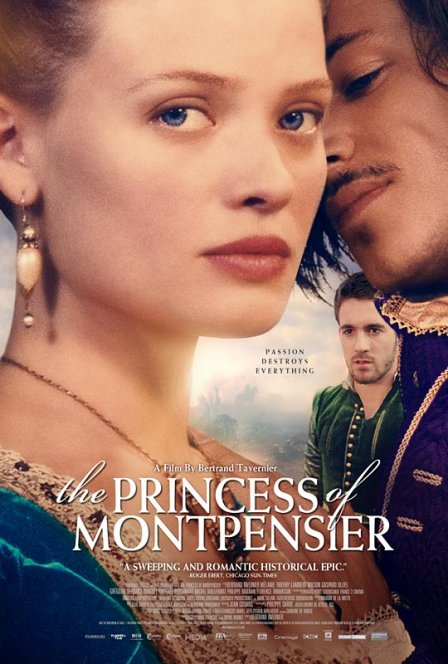Bertrand Tavernier’s The Princess of Montpensier sets a personal conflict against the backdrop of the tumultuous religious wars in late-16th-century France. This blend of history and fiction is very much a Tavernier film, with all his standard virtues and faults: effortless evocation of a time and place, pacing that walks a fine line between deliberate and slack, and more nourishment for the mind than the heart.
Princess fleshes out the skeletal 1662 story by Madame de La Fayette into an intimate epic. At the core of the plot’s abundant intrigue is a love triangle: luminous young Marie de Mézières (Mélanie Thierry) is forced for political and financial reasons to marry the Prince de Montpensier (Grégorie Leprince Ringuet), though she loves the roguish Henri de Guise (Gaspard Ulliel). The triangle is almost a pentagon: in addition to Marie’s husband and true love, two more men fall in love with her, but neither becomes a true contender for her affections.
One of these men is the Comte de Chabannes (Lambert Wilson), who has turned away from the senseless slaughter between Catholics and Huguenots and refuses to fight for either side. When the prince rushes back to war shortly after his wedding, he entrusts Chabannes with the education of his bride. It is then that the movie really takes off, because Chabannes is its conscience, and his friendship with Marie is more affecting than both her cold relations with her jealous husband and the torch she carries for the passionate but mercurial Guise. By placing Chabannes at the heart of the film, Tavernier proposes something dramatically risky: the idea that some friendships can run deeper than sexual love. A less mature and sophisticated filmmaker would have focused on the forbidden affair. I applaud Tavernier for his choice, but it doesn’t pay off as movingly as it might have. His film, unfortunately, falls short of tragedy.
As he has in earlier films, Tavernier flings a callow young woman into a merciless world of men only to demonstrate that the men are even more poorly equipped than the woman to meet that world’s challenges. Guise condescendingly calls Marie a “doe in our midst,” and the prince promises to “pluck glory” from his latest military campaign. But there is no glory for these warriors, only dirt, blood, fear, and death. The fighting is clumsy and barbaric, mirroring the violence of social customs — of marriages and alliances made for callous, venal expediency. “Love is awkward,” Marie’s mother consoles her, meaning true feelings are best avoided. But Marie soon learns marriage without love is just as awkward, in an uncomfortable wedding-night scene in which her virginity must be proved. That blood provides this proof underscores the connection between physical and emotional warfare. She also finds her true feelings are not easily suppressed. By the end of the film, Marie has rejected love, just as Chabannes has rejected war, and while she is unhappy, she at least seems to have achieved a hard-won freedom. Most of her suitors, meanwhile, are compromised, embittered, or dead. Only the Duc d’Anjou (Raphaël Personnaz), the future King Henri III, possesses the power and wiles to come through unscathed.
Princess shares some characters, events, and themes with Patrice Chéreau’s Queen Margot (1994) and Michael Hirst’s Elizabeth (1998), but Tavernier’s approach couldn’t be more dissimilar. Chéreau’s epic is entertainingly overripe — bodice-ripping grand guignol with hot blood flowing through (and often spurting from) its veins, while Hirst’s smooths out and juices up the complexities of the events it depicts. Tavernier takes a more solemn, naturalistic tack. He transports us to the late 1500s with the same incredible immediacy he has shown in his many other period pieces, avoiding both pedantry and anachronism and trusting us to puzzle things out. There is not a false note in the film. Much of the credit for this belongs to Jean Cosmos’s literate dialogue, as well as Caroline de Vivaise’s costumes and Guy Claude François’s sets, which always seem vividly real without calling undue attention to themselves. The performances, too, are uniformly fine, with Thierry and Wilson the standouts in the more nuanced roles and Personnaz entertaining in the flashiest. The Princess of Montpensier has so much to recommend it that its failure to achieve the weight of true tragedy is all the more disappointing. It will make you think, certainly, and it will make you feel — just not quite enough.

